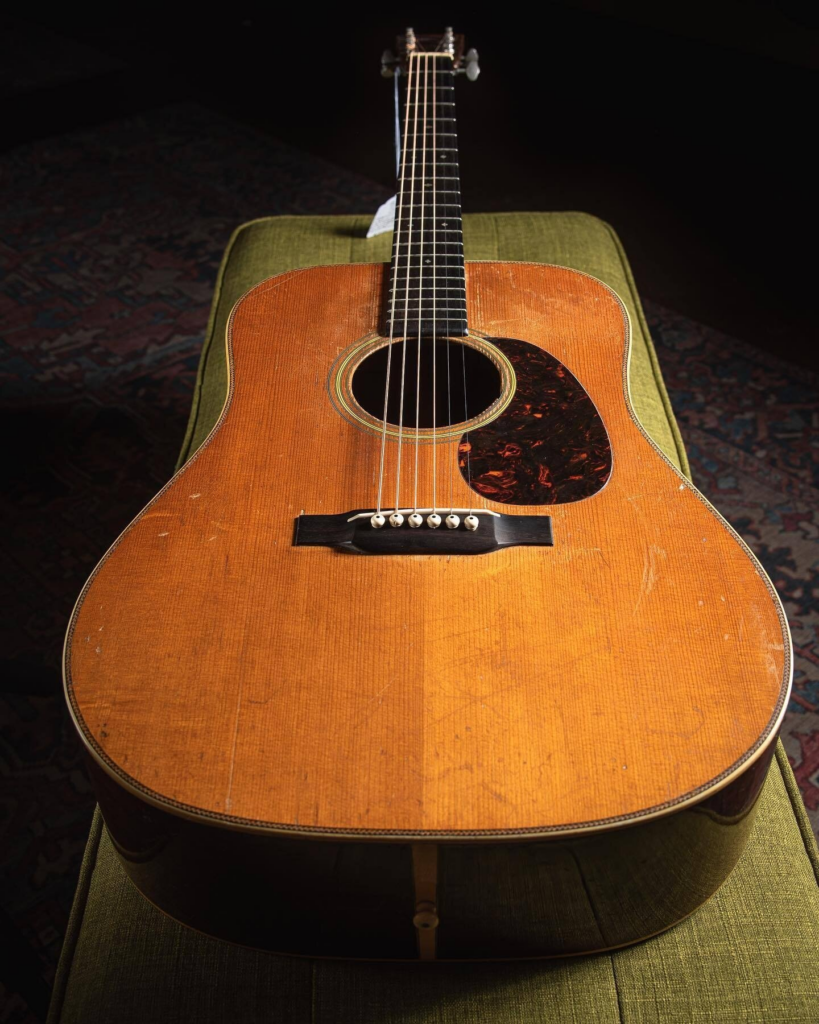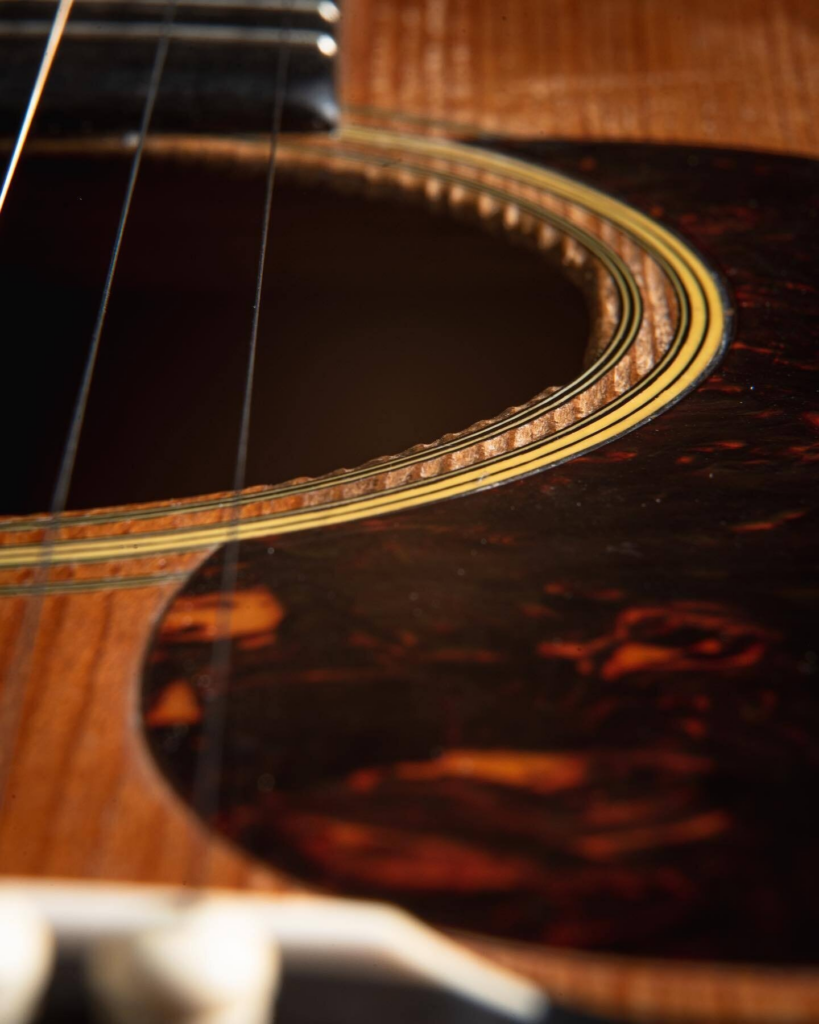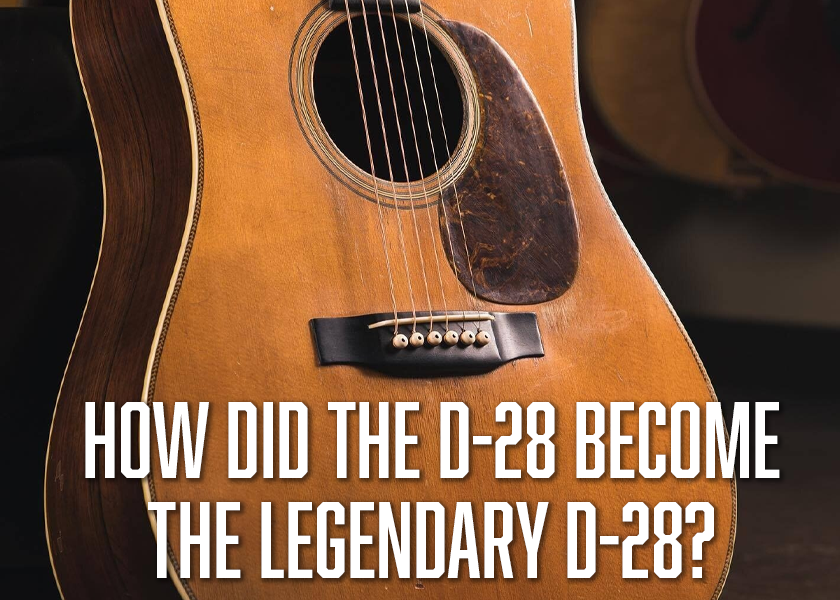Most of the iconic collectible instruments have a story that hangs on key players. The sunburst Les Paul with Clapton (or Bloomfield or Page). The Stratocaster with Buddy Holly or Hendrix. The J-200 with Ray Whitley. The F-5 mandolin with Bill Monroe. The Granada banjo with Earl Scruggs.
The Martin D-28 is a different story. Like the other iconic models, the D-28 is considered to be the best of its class – its class being acoustic flat-top guitars. But unlike the others, the D-28’s story has no guitar hero to fill in the blank when an aspiring guitarist says “I want a guitar like the one that <fill in the blank> plays.
The closest the D-28 came to having celebrity connections was in the 1960s and early ’70s, when the first hot, lead flat-top pickers emerged. Although the D-28 had been around since 1931, it didn’t really move into the spotlight until 1964, when Doc Watson made his first recordings (using a borrowed guitar). But Doc only played a D-28 for four years before he switched to a Gallagher in 1968.
Watson inspired Clarence White, whose fancy pick work initially would have been heard only by bluegrass fans through his tenure with the Kentucky Colonels in 1964 and ’65. Clarence played a 1935 D-28 with a soundhole that a previous owner had enlarged. White sold that D-28 in 1965 when he started playing a Telecaster. From 1968 until his death in 1973, he played with the Byrds, who showed off his acoustic picking nightly to rock and roll audiences, but the eventually famous D-28 with the enlarged hole was long gone by that time.
Clarence’s D-28 found its way into the hands of Tony Rice who, like Clarence, was a bluegrasser intent on expanding into other genres, which in Rice’s case was jazz. A nine-year-old Rice had seen Clarence’s D-28 in 1960 backstage at a radio performance, and in 1975, Rice tracked it down. Rice and the D-28 first gained notoriety in 1977, on the David Grisman Quintet’s first recording. By 1981, the D-28 with the oversized soundhole had become the Tony Rice model, a regular-production model. There was only one catch: the signature model was not a Martin. It was made by the Santa Cruz Guitar Co.
In the meantime, Nashville-based Norman Blake stepped out from session work with his first solo album in 1972. Among Norman’s many guitars was an extremely rare 1933 12-fret D-28 with sunburst finish.
This is a good spot to start keeping in mind that before the 1970s fans actually saw very little of their favorite artists. In those days before music videos and guitar-oriented magazines, the only visual of an artist would be at a live performance or on an album cover. Only the most commercially successful artists appeared occasionally on Johnny Carson’s late night TV show, or the weekly musical shows such as Ed Sullivan’s variety show, the folk-focused Hootenanny, or the pop-oriented Shindig and Hullabaloo. Given the technical quality of TV in those days, identifying a D-28 might have been difficult.

While the D-28 may have experienced a mini-explosion of exposure in the late ’60s and early ’70s, there was already a well-established demand for older models by then. Clarence White’s father had been buying used ones and fixing them up for resale, and he was on such a quest when he took Clarence into a music store in 1959 and bought the one with the chewed-out soundhole.
As the accepted top acoustic model, it’s not surprising to find the D-28 on the pop airwaves in the 1960s. Paul Simon played a D-28 on “Mrs. Robinson” in 1967. A year later, Paul McCartney played a D-28 on “Blackbird,” which would become the Beatles’ most-copied acoustic guitar part, but it’s doubtful that anyone noticed, because the Beatles were already strongly associated with the acoustic/electric Gibson J-160E, and the more lasting image of McCartney with an acoustic remained his performance of “Yesterday” on the Ed Sullivan show, playing an Epiphone Texan. Again, who knew, just by hearing a record, what guitars these guys were playing?
Looking a little farther back, into the folk era, which gave acoustic guitars wider exposure than bluegrass did, the D-28 was seldom seen. Bluesy folk artist Josh White played Martins, but smaller-bodied models. Fred Hellerman of the Weavers also played a smaller Martin (a 12-fret, wide-neck classical model set up with steel strings, which became the “folk guitar”). Joan Baez played a Martin 0-45. The guitars pictured on the cover of Peter, Paul and Mary’s debut album were classical-inspired. Dylan played a J-50, a re-topped Nick Lucas, a J-200 and other guitars, but not a D-28.
The primary sighting of a D-28 in the folk era would have been in the Kingston Trio, whose heyday was from 1958 to around 1964. Aside from the occasional simple riff to kick off a song, Bob Shane just strummed his D-28 through the Trio’s repertoire. He played “off the rack” D-28s, new instruments, not vintage D-28s. His use of a D-28 is not so important as an influence as it is yet another indication that the D-28 was already established as the go-to model for acoustic rhythm.

Going farther back, it’s hard to find influential recordings of acoustic flat-top guitars, much less influential acoustic guitarists. In country music, Cowboy Copas played a fairly simple lead line on his 1960 hit “Alabam,” and on his few TV appearances played a newer D-28. Sonny James played the lead part on his 1956 hit “Young Love,” probably on the D-28 that he held an early publicity photo. Hank Snow took a lead break on his 1950 classic “I’m Moving On,” probably using his 1935 D-28, and on some TV appearances he played a later D-28 with his name inlaid in the fingerboard. And there is a photo of Hank Williams with a D-28.
However, the level of influence these stars might have had on the D-28’s popularity is arguable. Copas was never a major star and his career ended abruptly in a plane crash in 1963. At the height of James’s fame, he was more likely to be seen with fancier guitars, specifically an Epiphone Excellente or a Martin D-45. Snow, too, favored fancier onstage guitars, such as a custom J-200, that would better match his stage attire. And for Hank Williams, the D-28 (as well as the Gibson SJ he was pictured with) was always as much stage prop as musical tool. Again, the use of a D-28 by these country artists is not a matter of influence, rather it is indicative that the D-28 was already established.
Continuing on back, we do find a truly influential guitarist in Merle Travis, a Kentucky native who came up through country radio barn dance programs and began recording for Capitol in 1946. On some of his hits, such as “Divorce Me C.O.D.” he was backed by a Texas swing band, with no lead guitar, but on his eight-song album of coal mining songs, which included such eventual classics as “Dark as a Dungeon” and “Sixteen Tons,” his backup was solo guitar. The rhythm element of Travis’s fingerpicking style was provided by his thumb crashing into one or more of the bass strings, an effect that a D-28 could provide better than any other guitar. Early in his career Travis played a Gibson L-10, and after 1951, he was known for flashy, custom-made electric Gibson Super 400. But in 1946, he acquired a 1941 D-28 that seemed perfectly designed for “Travis picking,” with a powerful bass and a cutting treble tone for melody work.

Travis took his D-28 to Paul Bigsby, a part-time guitarmaker in Downey, CA, to have a new neck made. For the Martin, as well as for a solidbody electric that Travis ordered from Bigsby, he specified a headstock with all the tuners on the same side. Anyone catching a glimpse of Travis in the late ’40s and early ’50s would have seen this D-28. However, if a guitarist went into a guitar store asking for a guitar like Merle Travis’s, chances are slim that a dealer would know that the guitar with the distinctively non-Martin headstock was actually an older Martin D-28. Also, in the big picture of guitar history, Travis’s electric Bigsby would far overshadow his D-28.
A year before Travis picked up a D-28, several photos of Bill Monroe appeared – one in front of a WSM microphone, the other with an NBC mic – showing the Father of Bluegrass with a D-28. Although Monroe would always be identified as a mandolinist, beginning with the Monroe Brothers in 1936, the type of guitar that was used in his band, the Blue Grass Boys, would have been influential on the growing number of bluegrass devotees. Monroe had played a D-28 – according to legend it was his guitarist Clyde Moody’s 1936 model – on the kickoff lick on his 1940 recording of “Muleskinner Blues,” but listeners would have had no way of knowing what guitar it was. If they had witnessed his debut performance on the Grand Ole Opry in 1939, they would probably have seen him playing the instrument that Cleo Davis, his original guitarist, is pictured with – a natural-top Gibson J-35. And if they had looked at a band photo in 1945 they would have seen newly arrived Blue Grass Boy Lester Flatt holding a natural-top J-35. (Was this actually Monroe’s guitar and, if so, was it the same one Cleo Davis is pictured with?) The notion that a J-35 was the preferred guitar in bluegrass would have been further established by earlier photos of the Monroe Brothers, which showed Charlie Monroe with a sunburst J-35.
Though Monroe never featured it in the manner of an iconic model, the D-28 was nevertheless of utmost importance to him, as he revealed in 1965 when his guitarist, the free-spirited Peter Rowan, managed to lose Monroe’s 1939 D-28 (a 1941 in some accounts). According to Monroe discographer Neil Rosenberg, it was stolen from Bill’s son James’s car in Nashville. Monroe allegedly gathered the band together and said, “Boys, we have lost our sound.” To the rest of the world, the sound of bluegrass may have been either Monroe’s F-5 mandolin or Earl Scruggs’ Granada banjo, but to Monroe, it was a D-28.
Continuing backward into the 1930s, in blues, the most guitar-centric genre, the D-28 was seldom seen. There’s a picture of the Lonnie Johnson trio in 1941, with Johnson playing what looks like a 00-18, and Johnson’s rhythm guitarist, Dan Dixon, playing a D-28. But other bluesmen in the 1930s played a variety of flat-top, archtop and resonator guitars, but few if any would have had the means to buy a new or nearly new D-28.
In country music in the 1930s, Jimmie Rodgers played smaller Martins. Maybelle Carter played an archtop. Gene Autry played smaller Martins until he ordered the first D-45. The singing cowboys mostly followed Autry’s lead toward fancier guitars, particularly Gibson’s Super Jumbo (J-200). In popular music, Nick Lucas played his small-bodied Gibson signature model. Eddy Lang, the hottest jazz player, played archtops, as did virtually all of the jazzers who followed him.
We find a couple of D-28s in the “family album” booklets of Chicago’s WLS, home of the National Barn Dance. In 1940, there’s Lester McFarland, aka “Mac” of Mac and Bob, a blind guitar/mandolin duo, playing a D-28. In 1936, one of the guitarists in The Hilltoppers (either Tommy Tanner or Don Wilson) is playing a D-28. These artists had some degree of exposure on clear-channel WLS, but their influence on guitarists would be limited by the audio-only nature of radio. Still, this is is more evidence that the D-28 was already becoming established as the preferred acoustic guitar.
We’re almost back to the beginning of the model, to 1931, when Martin introduced two dreadnoughts, calling the rosewood version the D-2 and then quickly renaming it the D-28. Martin made only seven D-2’s, one of which was bought by Luther Ossenbrink, aka “Arkie the Arkansas Woodchopper,” a star on the WLS National Barn Dance from the late 1920s into the ’40s. Arkie had his name inlaid in script on the fingerboard of his D-18, and he is more famous today for this guitar, which now resides in the Country Music Hall of Fame, than for his recordings, but when he acquired the D-2, he was at the peak of his recording career. His records for Supertone, Conqueror and other labels from 1929-30 featured him with solo guitar (he was probably Supertone’s answer to Jimmie Rodgers). Here, finally, is the artist who put the D-28 on the map.
Not so fast with the conclusions. In the Barn Dance booklets, Arkie is pictured in 1930 with a small-body flat-top with fancy fingerboard inlay and a wide pearl top border, which is probably the guitar he used on his recordings. He doesn’t appear in the booklet again with a guitar until 1933. In a studio photo, he has a small, plain guitar, probably a 00-18. In a second shot he is onstage, playing a Martin dreadnought, but it lacks the “Arkie” inlay. He appears in the 1934 booklet with the plain guitar. His next appearance in the booklet is not until 1941, with a guitar made by the Larson Brothers of Chicago. It would be foolish to conclude that Arkie never actually used his D-2, but the absence of his D-2 from the WLS booklets would undermine any argument that Arkie might have had a major influence on the demand for D-28s.
I’ve assumed that, as with the other iconic models, there must be a monumental musical event somewhere in the model’s history, but for the D-28 the critical factor is not an artist at all but, ironically, the Martin company. What caused older Martin D-28s to become so in-demand? The answer is easy: new Martins. Or, to be more specific, changes in new Martins. In 1946, when Martin changed the top wood from Adirondack spruce to Sitka, did no one at Martin think guitarists might notice that this year’s Martin didn’t sound quite as good as last year’s? That same year folks at Martin should have jumped for joy when Merle Travis put down his Gibson and picked up a D-28, but didn’t anyone at Martin wonder why Merle chose an older D-28 instead of a new ’46 model. It’s possible that no one noticed or, if they did, they thought the difference between Adirondack and Sitka wasn’t big enough for most guitarists to notice. But what about 1968, when Martin switched the bridgeplate from maple to rosewood, and then, in 1969, changed the back and sides from Brazilian rosewood to Indian? Surely someone at the company noticed the difference.
Guitar players definitely noticed the difference, and the market for vintage D-28s was born. Martin didn’t react to the demand for older D-28s until 1976, when the HD-28 was introduced, bringing back the scalloped bracing that and the herringbone top border that had been eliminated in late 1944 and early 1947, respectively. It would be 1985 before Martin would bring back the all-important Brazilian rosewood back and sides to a D-28 model.
In fairness to Martin, Gibson and Fender made similar blunders. Gibson ensured that a guitarist wanting a single-cutaway Les Paul had to buy an old one, because the model was not offered through most of the ’60s. And Fender not only made a series of small but ultimately significant cost-cutting changes in the Strat and Tele, they relegated those two soon-to-be classic models to positions in the product line below the more modern Jazzmaster and Jaguar.
Getting back to the original question of how the D-28 became the legendary D-28, it seems to have done it mostly on its own merits, with a little help from numerous artists and with a strong – though ironic and unintended – assist from the Martin company. It was simply the best model of its kind, and that was enough.
Walter Carter
Founder of Carter Vintage Guitars

Leave a Reply